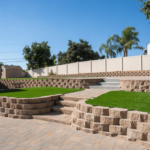For households hoping to save energy expenses and their carbon footprint. Installing solar panels is a progressive move toward sustainable energy. The visual appeal and calm of outdoor areas, however, frequently discourage people from exploring solar alternatives.
Using solar panels integrated into your landscape’s features or existing structures is one creative strategy. Pergolas, carports, and garden trellises are a few examples of structures that can use solar panels as roofing. They retain their effective solar energy harvesting while blending in perfectly with the overall appearance.
Looking at solar panels that may be used as decorative elements in your environment is another tactic to consider. Certain firms provide solar panels that are able to be shaped into different patterns, forms, or even artwork. You may capture renewable energy and improve the aesthetic appeal of your outdoor area. By transforming solar panels into visually striking focal pieces.
Additionally, it may be quite helpful to collaborate with landscape designers who specialize in solar solution integration into outdoor spaces. In order to provide natural shadowing and concealment, they might carefully position panels within greenery, utilizing trees or bushes. This method maximizes solar energy generation without compromising the symmetry of your environment.
Ground-mounted solar arrays can also be taken into consideration if rooftop installation isn’t practical or desired. These can be placed with purpose in less noticeable places on your land. Including at corners or next to property borders. With the right design, these ground-mounted arrays may produce solar energy effectively and mix in well with your landscape.
In conclusion, the peace or beauty of your environment doesn’t have to be sacrificed in order to incorporate solar panels. You can easily integrate renewable energy into your outdoor spaces and lower your carbon footprint without compromising aesthetics with clever design choices and thoughtful placement.
Strategic Placement:
Placing the solar panels in the right spot can help you maintain your outdoor haven. Collaborate closely with a solar installer to determine the best spots to maximize solar exposure and minimize visual obstructions. While ground-mounted arrays can be hidden away in less noticeable regions or subtly placed along property boundaries, rooftop installations are a popular option for preserving ground-level aesthetics. You may use solar electricity without sacrificing the aesthetic appeal of your outdoor area by carefully evaluating placement alternatives.
Customized Designs:
Big, universally-sized solar panels are a thing of the past. Solutions made to match your unique requirements and aesthetic tastes are available thanks to modern solar technology. Look at modern, low-profile panel designs that complement your current landscape and architectural features. Furthermore, inventive installation choices like an awning or pergola may be realized thanks to clever mounting techniques. These alternatives not only provide clean energy but also give your outdoor sanctuary shade and architectural character.
Landscaping Integration:
One inventive technique to balance outdoor beauty with sustainable energy is to incorporate solar panels into already-existing landscaping elements. To create a seamless combination of aesthetics and practicality, think about adding panels to garden borders, retaining walls, or ornamental fences. Choose solar-powered lights, fountain pumps, or pathway lighting for a more natural look that will blend in with your landscape design, save electricity, and improve the atmosphere at night.
Camouflage Techniques:
Camouflage methods provide a covert substitute for regular panel installations for homeowners looking for a discrete solar option. Discover cutting-edge solar technologies, such as solar shingles or roof tiles, which imitate the appearance of traditional roofing materials and mix in perfectly with your roofline for a unified appearance. You can deliberately include landscaping features like trellises, ivy walls, or climbing plants in order to hide panels and lessen their visual impact on the outside space.
Community Collaboration:
Community cooperation may be able to install solar panels in some situations without endangering outdoor sanctuary areas. Investigate group solar projects like communal solar gardens or shared solar arrays by collaborating with your neighbors or homeowner associations. You can foster a feeling of community and environmental care while maximizing energy output and limiting individual visual effects by coordinating installations and pooling resources.
Integrating Solar Power
Installing solar panels may improve rather than take away from your outdoor haven with thoughtful planning and creative design techniques. You can easily integrate solar electricity into your environment while painting its beauty and peacefulness using a variety of strategies, such as strategic placement, unique designs, landscaping integration, and camouflage techniques.
You may increase energy efficiency while keeping the feel of your sanctuary by carefully positioning solar panels in spots that receive the most sunshine without impeding picturesque vistas or changing the flow of your outdoor space. Whether you want sleek, contemporary panels or ones that go in perfectly with the surroundings, customized designs provide you the freedom to customize solar panels to your exacting aesthetic standards.
Another way to tastefully integrate solar electricity into your outdoor retreat is through landscaping integration. By utilizing trees, bushes, or other vegetation to create natural shade and camouflage, you may work with landscape architects to seamlessly integrate solar panels into the existing flora. This method encourages biodiversity and the health of the ecosystem in addition to improving the aesthetic appeal of your area.
Solar panels are further hidden by camouflage techniques, which make sure they match perfectly with their surroundings. You may take advantage of solar energy without sacrificing the tranquility of your outdoor area. Do it by using inventive materials that imitate natural textures or strategic panel positioning that conceals panels from view.
Take advantage of these sun-harvesting techniques to create an environmentally conscious outdoor space that is both harmonious and sustainable. You may appreciate the wonders of nature and help ensure a more sustainable and environmentally friendly future. Especially for future generations by cleverly and imaginatively incorporating solar electricity.






